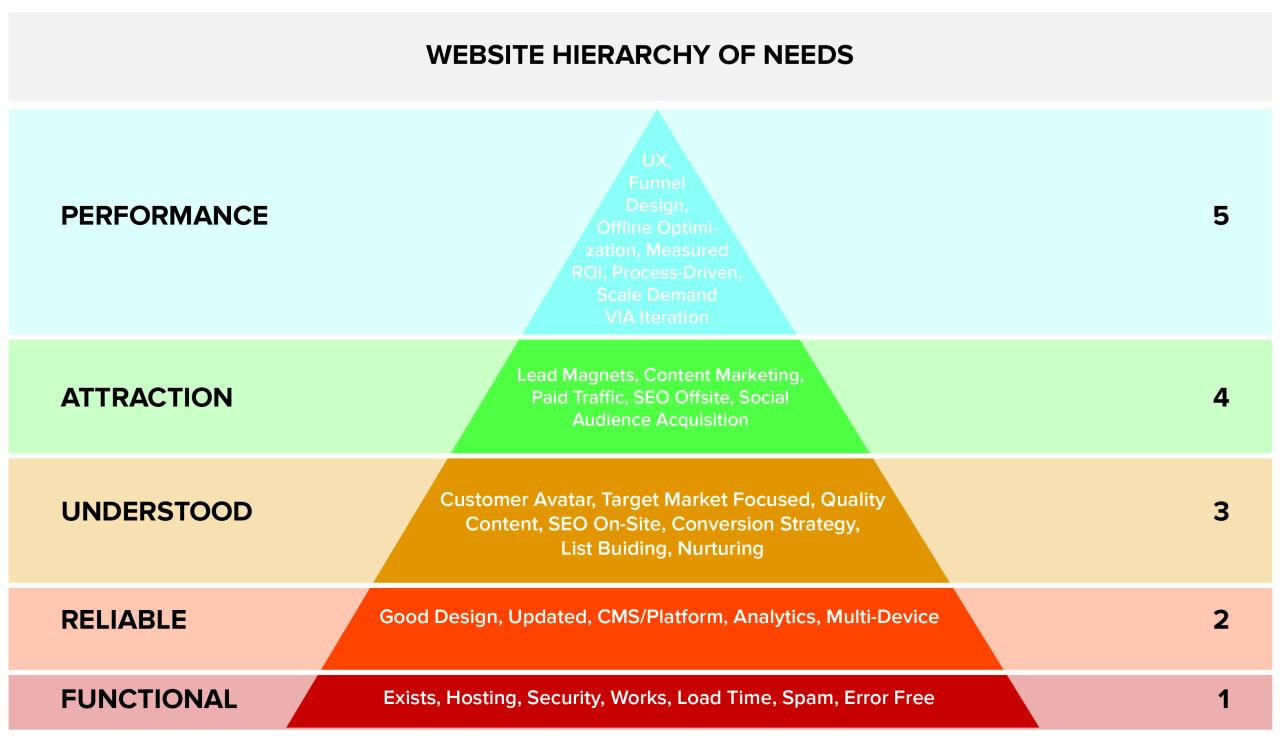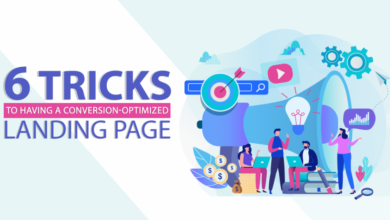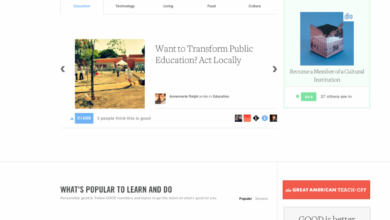
Priority of Positioning in Website Design
Priority of positioning in website design isn’t just about aesthetics; it’s the cornerstone of a successful online presence. Think of your website as a conversation – where do you place the most crucial information to grab attention and guide users towards your desired outcome? We’ll dive into the science behind effective placement, exploring everything from above-the-fold content and visual hierarchy to the strategic positioning of call-to-actions and the critical importance of mobile responsiveness.
Get ready to optimize your website for maximum impact!
From understanding the psychology of user behavior to leveraging data-driven insights through A/B testing, we’ll unravel the secrets to creating a website that not only looks great but also converts. We’ll cover best practices for different industries and explore real-world examples to illustrate the power of strategic placement. Prepare to transform your website from a static collection of pages into a dynamic, user-centered experience.
Above the Fold Content

Source: com.au
The “above the fold” area of your website, the portion visible without scrolling, is prime real estate. It’s the first impression, the initial handshake, the moment of truth that determines whether a visitor will stick around or bounce. Effective above-the-fold design is crucial for maximizing user engagement and driving conversions. It’s about immediately communicating your value proposition and enticing users to explore further.
Designing for the above the fold requires a strategic approach. You need to prioritize the most critical information – the elements that will instantly grab attention and resonate with your target audience. This involves careful consideration of visual hierarchy, clear messaging, and a compelling call to action. The goal is to create an immediate connection and encourage users to take the desired next step.
Effective Above-the-Fold Design Elements Across Industries
The optimal above-the-fold content varies depending on your industry and business goals. However, several core principles remain consistent.
For e-commerce websites, the hero image should showcase a high-quality product photo or a captivating lifestyle image, accompanied by a concise product description and a clear call to action like “Shop Now” or “View Details.” A prominent price display and potentially a limited-time offer can further enhance the impact. Consider using high-quality visuals that are fast-loading.
SaaS companies often benefit from a concise value proposition, highlighting the key benefits of their software. A short, impactful headline, a brief description of the problem solved, and a strong call to action like “Start Free Trial” or “Request a Demo” are effective strategies. Visuals might include screenshots of the software interface or happy customer testimonials.
Blogs typically use a compelling headline and a brief, engaging introduction to entice readers to delve into the full article. High-quality featured images are crucial for attracting attention. A clear call to action might be “Read More” or a social sharing button. Think of this section as a strong “hook” to pull readers in.
Impact of Above-the-Fold Strategies on User Engagement and Conversion Rates
The effectiveness of different above-the-fold strategies significantly impacts key metrics. A poorly designed above-the-fold section can lead to high bounce rates and low conversion rates, while a well-designed section can drastically improve engagement and drive conversions.
For example, a website with a cluttered above-the-fold section, filled with too much text or low-quality images, will likely deter users. Conversely, a website with a clean, visually appealing above-the-fold section that clearly communicates its value proposition is more likely to capture attention and encourage further exploration. A/B testing different above-the-fold designs can provide valuable insights into which strategies are most effective for a particular website.
Studies have shown that websites with clear calls to action above the fold see significantly higher conversion rates. Similarly, websites with high-quality images and compelling headlines tend to have lower bounce rates and longer session durations.
Above-the-Fold Comparison of Leading Websites, Priority of positioning in website design
Analyzing the above-the-fold strategies of successful websites can provide valuable insights. Below is a comparison of three well-known websites, highlighting their approaches.
| Website Name | Primary Call to Action | Visual Emphasis | User Experience |
|---|---|---|---|
| Amazon | Search Bar, “Shop by Department” | Product Images, Deals Banners | Highly efficient, product-focused |
| Mailchimp | “Sign Up Free” | Clean design, illustrative graphics | Simple, clear value proposition |
| Airbnb | Search Bar, “Find your perfect stay” | High-quality travel photography | Inspirational, visually engaging |
Visual Hierarchy and User Flow
Website design isn’t just about aesthetics; it’s about guiding users effortlessly through your content. A well-designed website uses visual hierarchy and a clear user flow to achieve this, ensuring visitors find what they need quickly and intuitively. This involves strategically arranging elements to create a natural path for the eye, making the most important information instantly accessible.Visual hierarchy is the arrangement of elements on a page to communicate their relative importance.
It leverages visual cues to prioritize content, directing the user’s attention in a specific order. This isn’t arbitrary; it’s a deliberate strategy based on principles of visual perception and user experience. Understanding and applying these principles is crucial for effective website design.
Visual Cues for Guiding Users
Effective visual cues help establish a clear hierarchy. Size, color, and contrast are powerful tools. Larger elements naturally draw more attention than smaller ones. Think of a headline – it’s typically much larger than the body text. Color also plays a significant role; bright, contrasting colors immediately capture the eye, while muted colors recede into the background.
Similarly, high contrast between elements (like dark text on a light background) improves readability and emphasizes key information. For example, a bright red “Buy Now” button against a white background immediately stands out, encouraging clicks. Conversely, subtle grey text might be used for less important information, like copyright details.
User Flow Diagram: Optimal Navigation
Imagine a website selling handcrafted jewelry. The user flow could be represented as follows:* Homepage: A large, high-quality hero image showcasing a selection of jewelry pieces, accompanied by a clear call to action (“Shop Now”). This immediately directs the user towards the product catalog.
Product Catalog
Organized neatly by category (e.g., earrings, necklaces, bracelets), with high-resolution product images and concise descriptions. Each product page features a prominent “Add to Cart” button.
Shopping Cart
A clear summary of the selected items, with options to adjust quantities and proceed to checkout.
Checkout
A straightforward, multi-step process with clear instructions and secure payment options.
Confirmation Page
A final confirmation of the order, along with order details and tracking information.This diagram showcases a logical progression, leading the user smoothly from browsing to purchase. Each step is clearly defined and intuitive, minimizing friction and maximizing conversion.
Comparison of Visual Hierarchy Techniques
The F-pattern and Z-pattern are two commonly observed reading patterns on websites. The F-pattern suggests users scan horizontally across the top of the page, then vertically down the left side, forming an “F” shape. This is often seen on websites with significant amounts of text, like news sites or blogs. The Z-pattern, on the other hand, suggests a diagonal scan from top left to bottom right, following a “Z” shape.
This is often more suitable for websites with less text and more visual elements. The effectiveness of each pattern depends heavily on the content and the user’s goal. For instance, a website prioritizing quick information delivery might benefit more from a Z-pattern, while a website with in-depth articles might be better served by an F-pattern. Ultimately, a combination of both might be the most effective approach, ensuring that critical information is presented in a manner that aligns with typical user scanning behavior.
Importance of Call to Actions (CTAs)
A website, no matter how beautifully designed or informative, is ultimately judged by its effectiveness in converting visitors into customers or achieving its desired goals. This is where the call to action (CTA) steps in. A well-placed and designed CTA is the bridge between visitor engagement and desired outcome. It’s the crucial element that guides users towards taking the next step, whether it’s making a purchase, signing up for a newsletter, or downloading a resource.
Without compelling CTAs, your website risks becoming a digital brochure, leaving potential conversions untapped.A strong CTA is more than just a button; it’s a strategic element of your website design. It requires careful consideration of placement, design, and the overall user experience. The goal is to make the CTA so obvious and appealing that users can’t help but click.
This involves understanding user behavior and employing best practices to optimize conversion rates.
Best Practices for Positioning and Designing Prominent CTAs
Effective CTA placement is paramount. They shouldn’t be hidden or buried within a sea of text. Instead, they need to be strategically positioned within the user’s visual flow. Consider using contrasting colors, clear and concise language, and compelling verbs to make them stand out. The design should also align with the overall website aesthetic, maintaining consistency and brand identity.
Avoid using generic calls to action like “Learn More” unless it’s highly relevant and specific to the content. Instead, opt for more action-oriented phrases like “Get Started Now,” “Download Your Free Guide,” or “Shop Now.” The language should directly reflect the desired user action.
Examples of Effective CTA Placements on Various Website Sections
The optimal placement of a CTA will vary depending on the specific page and its purpose. On a homepage, a prominent CTA above the fold, perhaps inviting users to explore a featured product or service, is often highly effective. This immediate call to action grabs the user’s attention immediately. Landing pages, designed for a single, specific conversion goal, usually feature a prominent CTA near the end of the page, summarizing the key benefits and encouraging immediate action.
Product pages should incorporate CTAs directly alongside the product description, making it easy for the user to add the item to their cart or proceed to checkout.
Factors Influencing CTA Click-Through Rates
Several factors significantly influence how often users click on your CTAs. Understanding these factors allows for optimization and improvement.
- Clarity and Conciseness: CTAs should be easy to understand and directly communicate the benefit of clicking.
- Visual Appeal: The design, including color, size, and shape, should be eye-catching and consistent with the overall website design.
- Placement and Visibility: CTAs should be strategically positioned within the user’s natural flow and be easily visible.
- Urgency and Scarcity: Creating a sense of urgency or scarcity (e.g., “Limited Time Offer”) can incentivize immediate action.
- Value Proposition: The CTA should clearly communicate the value the user will receive by clicking (e.g., “Get a Free Consultation”).
- Target Audience: The design and messaging of the CTA should resonate with the specific target audience.
- A/B Testing: Regular A/B testing of different CTA designs and placements is crucial for continuous optimization.
Mock-up of a Landing Page with Optimal CTA Placement and Design
Imagine a landing page for a new productivity app. The background is a clean, minimalist design with a high-quality image of a person happily working on a laptop. Above the fold, a concise headline states: “Boost Your Productivity with [App Name]”. Below the headline, a brief description highlights the key benefits: “Organize your tasks, manage your time, and achieve your goals effortlessly.” Mid-page, a section showcases key features with accompanying icons and short descriptions.
At the bottom of the page, a large, brightly colored button dominates the space. The button features bold, white text that reads “Download Your Free Trial Now!” Beneath the main CTA, a smaller, secondary CTA says “Learn More,” linking to a more detailed FAQ page. The overall color scheme is consistent with the app’s branding, creating a cohesive and professional look.
The prominent placement and compelling design of the main CTA guide users towards the desired action, downloading the free trial.
Impact of Mobile Responsiveness
In today’s mobile-first world, a website’s responsiveness is no longer a luxury; it’s a necessity for achieving high search engine rankings and a positive user experience. Google prioritizes mobile-friendly websites, meaning a site that isn’t optimized for mobile devices will likely suffer in search results, impacting its overall visibility and potential for attracting organic traffic. This section delves into the critical role of mobile responsiveness in website positioning.Prioritizing mobile-first design means developing your website with the mobile experience as the primary focus.
This approach ensures that the core content and functionality are flawlessly presented on smaller screens before adapting for larger desktops. The advantages are significant: improved user experience leading to increased engagement and conversion rates, better search engine rankings due to Google’s mobile-first indexing, and a streamlined development process. By focusing on the essential elements first, you can create a leaner, more efficient website that performs optimally across all devices.
Mobile-First Design and Search Engine Optimization
Google’s mobile-first indexing means that Google primarily uses the mobile version of your website to index and rank your site in search results. A poorly designed mobile site will directly impact your search ranking. Conversely, a well-optimized mobile experience signals to Google that your website provides a positive user experience, leading to higher rankings. A mobile-first approach ensures your site is both user-friendly and search engine friendly.
For example, a website selling handcrafted jewelry might see a significant drop in mobile traffic if their images are too large and slow to load on mobile devices, hindering navigation and potentially losing potential customers.
Responsive Design Examples
Responsive design uses flexible layouts, fluid grids, and flexible images to ensure optimal viewing across all devices. Consider a news website: on a desktop, the layout might feature a three-column design with articles, sidebars, and advertisements. On a tablet, this might condense to a two-column layout, while on a smartphone, it might become a single-column layout, prioritizing readability and ease of navigation.
Each screen size dynamically adjusts the content to fit, ensuring a seamless experience regardless of the device. Similarly, an e-commerce site using responsive design will adjust product images and descriptions to fit the screen size, ensuring a user-friendly shopping experience on all devices.
Adapting Content Placement for Various Screen Sizes
Adapting content placement involves strategically prioritizing key information for different screen sizes. For example, a crucial call to action (CTA) button might be prominently displayed at the top of a mobile page but placed strategically within the content flow on a desktop version. Navigation menus often collapse into hamburger menus on smaller screens, consolidating numerous links into a single, easily accessible icon.
Images may be resized or cropped to maintain aspect ratio and avoid distortion on smaller screens. A website offering online courses might prioritize course titles and short descriptions on mobile, with detailed information unfolding only when a user clicks to learn more.
Testing Website Responsiveness
Testing website responsiveness involves using a combination of tools and techniques to ensure optimal performance across different devices and browsers. Browser developer tools allow you to simulate different screen sizes and resolutions directly within your browser. Online responsive testing tools provide visual representations of how your website renders across various devices. Real device testing involves using actual smartphones, tablets, and laptops to assess the website’s functionality and user experience in real-world scenarios.
Furthermore, cross-browser testing is essential to ensure consistent performance across different browsers (Chrome, Firefox, Safari, Edge, etc.). By employing a multi-faceted testing strategy, you can identify and resolve any responsiveness issues before your website goes live.
Accessibility Considerations
Designing a website is about more than just aesthetics; it’s about creating an inclusive experience for everyone. Accessibility ensures that your website is usable by people with a wide range of disabilities, including visual, auditory, motor, and cognitive impairments. Ignoring accessibility not only excludes a significant portion of your potential audience but also impacts your brand reputation and can even lead to legal issues.
Prioritizing accessibility doesn’t mean sacrificing visual appeal. In fact, many accessibility features enhance the overall user experience for everyone. For instance, clear visual hierarchy and well-structured content benefit both users with visual impairments and those without. By focusing on semantic HTML, robust keyboard navigation, and alternative text for images, you can create a website that’s both beautiful and accessible.
Examples of Accessible Design Practices
Let’s explore some practical examples of how to incorporate accessibility features without compromising the visual design. Consider using sufficient color contrast between text and background to ensure readability for users with low vision. This can be achieved by using tools that measure contrast ratios, ensuring they meet WCAG (Web Content Accessibility Guidelines) standards. Another example is providing captions and transcripts for videos and audio content, making your content accessible to deaf and hard-of-hearing individuals.
Website design’s all about smart placement; getting the most important elements front and center is key. Think about how you structure your YouTube channel – similar principles apply! Check out this great article on getting it on with youtube to see how strategic positioning boosts engagement. Applying that same thinking to your website’s design can significantly impact user experience and conversions.
This also improves , as search engines can index this textual content.
Implementing Alt Text and Keyboard Navigation
Here’s a section of a website demonstrating best practices:
Imagine a section showcasing a new product. The image of the product would have detailed alt text, such as: <img src="product.jpg" alt="Sleek, modern blue laptop with a 15-inch screen, silver keyboard, and a powerful processor. Ideal for students and professionals alike."> This alt text provides a rich description for screen readers, while the image itself enhances the visual appeal for sighted users. The entire section would be navigable using only the keyboard, ensuring that users who cannot use a mouse can easily access and interact with the content.
Headings (h1-h6) would be used appropriately to structure the content logically, allowing for easy navigation via screen readers and keyboard shortcuts.
Impact of Poor Accessibility on User Experience and
Websites with poor accessibility create frustrating experiences for many users. Individuals relying on assistive technologies might encounter significant barriers, preventing them from accessing information or completing tasks. This can lead to lost sales, decreased brand loyalty, and negative word-of-mouth. Furthermore, search engines increasingly prioritize accessible websites, meaning poor accessibility can negatively impact your search engine rankings, reducing your visibility and reach.
Google, for example, actively penalizes websites that are not accessible.
A/B Testing and Iteration: Priority Of Positioning In Website Design

Source: a-ztechs.com
Optimizing website design for maximum impact isn’t a one-time event; it’s an ongoing process of refinement. A/B testing, a cornerstone of effective web design, allows us to systematically test different versions of a page to determine which performs better based on measurable data. This data-driven approach ensures that our design choices aren’t just aesthetically pleasing, but also effective in achieving our goals.A/B testing allows for the precise evaluation of content positioning’s impact on user behavior.
By creating variations of a page with subtle differences in element placement, we can directly measure the effect these changes have on key metrics like conversion rates, bounce rates, and time spent on page. This iterative process, informed by data, allows us to continuously improve the user experience and drive better results.
CTA Placement Variations
Let’s say we’re testing different positions for a prominent “Buy Now” button. Version A places the button at the bottom of the page, while Version B positions it directly beneath the product description. We’d run both versions simultaneously, directing equal traffic to each, and track which version generates a higher click-through rate on the button. A higher click-through rate on Version B would indicate that positioning the button closer to the product information is more effective.
Imagine Version A showing a simple, clean product image with the button at the bottom, whereas Version B has the button prominently placed below the detailed product features and benefits, immediately encouraging purchase.
Image Size and Engagement
Another example involves testing image size. Version A might feature a large hero image dominating the top of the page, while Version B uses a smaller image with more text above the fold. We would track metrics such as time spent on page and scroll depth. If Version B shows a higher engagement rate (longer time spent on page and greater scroll depth), it might suggest that a less visually dominant image allows users to more easily engage with other content, ultimately leading to better overall interaction.
This could indicate that users are distracted by the large image in Version A and don’t fully engage with the rest of the page.
Analyzing A/B Test Results and Iterating Design
After running an A/B test for a statistically significant period (ensuring enough data to draw reliable conclusions), we analyze the results. We compare the key metrics between the variations to identify the winning version. For instance, if Version B consistently outperforms Version A across multiple metrics, we’d adopt the design elements of Version B as the new standard.
This process is iterative. We might then conduct further A/B tests to optimize other elements based on the learnings from the initial test. The data informs every decision, continuously improving the design.
Key Metrics for A/B Testing
| Metric Name | Measurement Method | Target Value | Interpretation |
|---|---|---|---|
| Conversion Rate | Track the percentage of visitors completing a desired action (e.g., purchase, sign-up) | Increase of 10% or more | Indicates improved effectiveness in guiding users towards the desired outcome. |
| Bounce Rate | Percentage of visitors leaving the page after viewing only one page | Decrease of 5% or more | Shows improved engagement and relevance of content. |
| Average Session Duration | Average time spent on the page | Increase of 15 seconds or more | Suggests users find the content more engaging and valuable. |
| Click-Through Rate (CTR) | Percentage of visitors clicking on a specific element (e.g., CTA button, link) | Increase of 5% or more | Indicates improved visibility and appeal of the element. |
Concluding Remarks
Mastering the priority of positioning in website design is an ongoing journey, not a destination. By understanding the principles of visual hierarchy, optimizing for mobile, and continuously iterating based on data, you can create a website that not only attracts visitors but also guides them towards achieving your goals. Remember, every element on your website has a purpose, and strategic placement is the key to unlocking its full potential.
So, go forth and create a website that truly shines!
User Queries
What is the “above the fold” area of a website?
It’s the portion of your website visible without scrolling. Getting crucial information here is vital for grabbing attention.
How do I choose the right visual hierarchy for my website?
Consider your users’ goals and use size, color, and contrast to guide their eyes to important elements. A/B testing can help determine what works best.
What are some common mistakes in CTA placement?
Burying CTAs, using unclear language, or placing them in visually cluttered areas are all common mistakes. Make them prominent and easy to find!
How important is mobile responsiveness for website positioning?
Extremely important! Google prioritizes mobile-first indexing, so a poorly designed mobile experience will negatively impact your search ranking.





